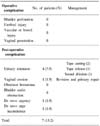Abstract
Purpose
We wanted to evaluate the clinical efficacy, safety and satisfaction of patients with IRIS-transobturator tape (TOT) operation for the women suffering with stress urinary incontinence.
Materials and Methods
53 women with stress urinary incontinence who underwent the TOT procedure between February 2004 and June 2005 were included in this study. Preoperatively, the patients were evaluated with history taking, a physical examination, a voiding diary, a one-hour pad test, uroflowmetry and the post voided residual urine. The procedure was carried out using a previously established method under local anesthesia for 37 patients and under spinal anesthesia for 16 patients. The post-operative symptoms and patient satisfaction were assessed by questionnaire.
Results
The patients' mean age was 49.6 years (average age: 35-73 years). The mean follow-up was 10.9 months (average follow-up: 3-20 months). The mean operation time was 30.2 minutes (average time: 20-50 minutes). The mean duration of the post operative indwelling catheter was 1 hour for local anesthesia and 18 hours (range: 14-20 hours) for spinal anesthesia. Of the 53 patients, 49 (92.4%) of the patients were cured and 4 (7.6%) were significantly improved. The postoperative complications were urinary retention in 4 patients, and tape exposure by vaginal erosion in 1 patient. De novo urgency occurred in 1 patient and de novo urge incontinence occurred in 1 patient.
Figures and Tables
References
1. Iosif CS, Bekassy Z, Ryhdstrom H. Prevalence of urinary incontinence in middle-aged women. Int J Gynaecol Obstet. 1988. 26:255–259.
2. Thomas TM, Plymat KR, Blannin J, Meade TW. Prevalence of urinary incontinence. Br Med J. 1980. 281:1243–1245.
3. Zaragoza MR. Expanded indications for the pubovaginal sling: treatment of type 2 or 3 stress incontinence. J Urol. 1996. 156:1620–1622.
4. Raz S, Sussman EM, Erikson DB, Bregg KJ, Nitti VW. The Raz bladder neck suspension: result in 206 patients. J Urol. 1992. 148:845–850.
5. Ulmsten U, Johnson P, Rezapour M. A three-year follow up of tension free vaginal tape for surgical treatment of female stress urinary incontinence. Br J Obstet Gynaecol. 1999. 106:345–350.
6. Nilsson CG, Kuuva N, Falconer C, Rezapour M, Ulmsten U. Long-term results of the tension-free vaginal tape (TVT) procedure for surgical treatment of female stress urinary incontinence. Int Urogynecol J Pelvic Floor Dysfunct. 2001. 12:Suppl 2. S5–S8.
7. Olsson I, Kroon U. A three-year postoperative evaluation of tension-free vaginal tape. Gynecol Obstet Invest. 1999. 48:267–269.
8. Ingelman-Sundberg A, Ulmsten U. Surgical treatment of female urinary stress incontinence. Contrib Gynecol Obstet. 1983. 10:51–69.
9. Stamey TA. Endoscopic suspension of the vesical neck for urinary incontinence in female: report on 203 consecutive patients. Ann Surg. 1980. 192:465–471.
10. Delorme E, Droupy S, de Tayrac R, Delmas V. Transobturator tape (Uratape®): a new minimally-invasive procedure to treat female urinary incontinence. Eur Urol. 2004. 45:203–207.
11. de Tayrac R, Deffieux X, Droupy S, Chauveaud-Lambling A, Calvanese-Benamour L, Fernandez H. A prospective randomized trial comparing tension-free vaginal tape and transobturator suburethral tape for surgical treatment of stress urinary incontinence. Am J Obstet Gynecol. 2004. 190:602–608.
12. Costa P, Grise P, Droupy S, Monneins F, Assenmacher C, Ballanger P, et al. Surgical treatment of female stress urinary incontinence with a transobturator tape (T.O.T) (Uratape®): short term result f a prospective multicentric study. Eur Urol. 2004. 46:102–107.
13. Cindolo L, Salzano L, Rota G, Bellini S, D'Afiero A. Tension-free transobturator approach for female stress urinary incontinence. Minerva Urol Nefrol. 2004. 56:89–98.
14. Song SH, Hong BS, Choo MS. Three-year outcome of the tension-free vaginal tape procedure for treatment of female stress urinary incontinence. Korean J Urol. 2003. 44:307–311.
15. Minaglia S, Ozel B, Klutke C, Ballard C, Klutke J. Bladder injury during transobturator sling. Urology. 2004. 64:376–377.
16. Fisher A, Fink T, Zachmann S, Eickenbusch U. Comparison of retropubic and outside-in transobturator sling systems for the cure of female genuine stress urinary incontinence. Eur Urol. 2005. 48:799–804.
17. Meschia M, Pifarotti P, Bernasconi F, Guercio E, Maffiolini M, Magatti F, et al. Tension-free vaginal tape: analysis of outcome and complication in 404 stress incontinent women. Int Urogynecol J Pelvic Floor Dysfunct. 2001. 12:Suppl 2. S24–S27.
18. McGuire EJ. Mixed symptomatology. BJU Int. 2000. 85:Suppl 3. 47–56.
19. Segel JL, Vassallo BV, Kleeman S, Silva WA, Karram MM. Prevalence of persistent and de novo overactive bladder symptoms after the tension-free vaginal tape. Obstet Gynecol. 2004. 104:1263–1269.
20. Ryu BS, Lee JB, Chung H. The change of urgency and effect on patient satisfaction after sling operation for stress urinary incontinence. Korean J Urol. 2004. 45:433–437.




 PDF
PDF ePub
ePub Citation
Citation Print
Print







 XML Download
XML Download